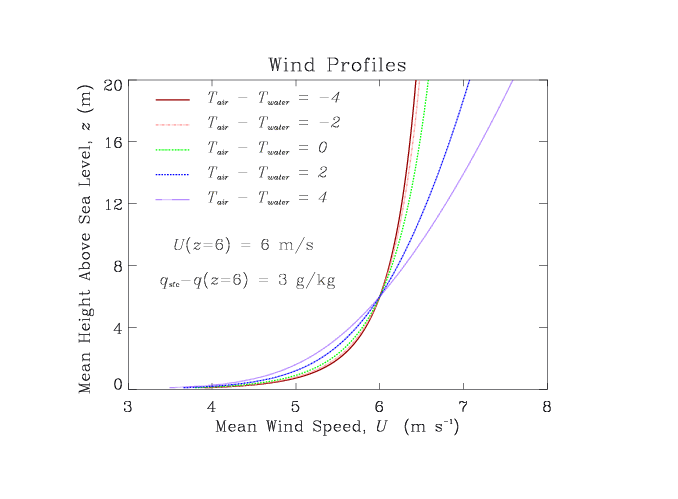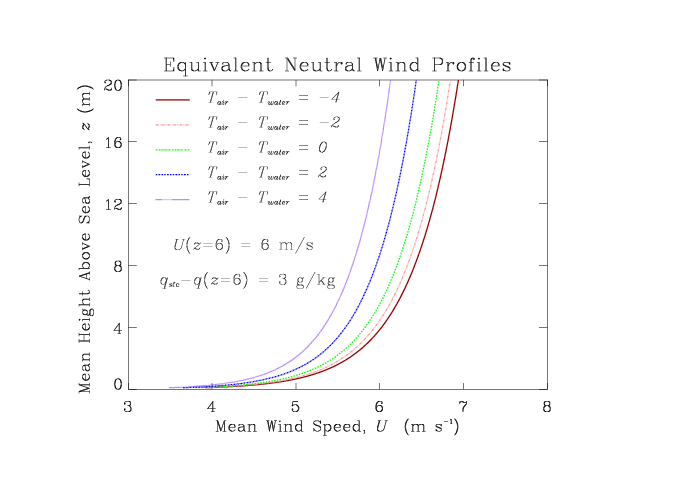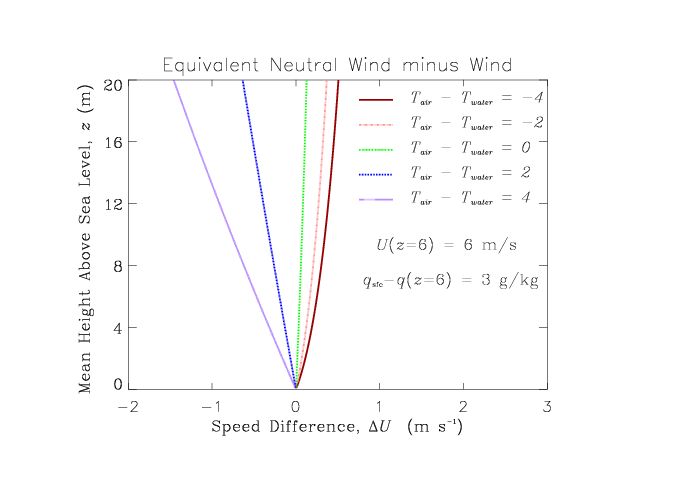Dr. Mark A. Bourassa, COAPS/FSU, Tallahassee FL 32306-2840
email: bourassa@coaps.fsu.edu
WWW: http://coaps.fsu.edu/~bourassa
Scatterometry
Scatterometers are active microwave sensors used to determine winds (speed and direction) over water. These sensors are usually satellite borne. As the satellite progresses in its orbit, the scatterometer measures the strength of signals returned from each location at several angles. These 'backscatters' are used to determine the wind direction and equivalent neutral wind speed [Tang and Liu, 1996].
Wind profiles
Wind speed increases approximately logarithmically with height. The variation from a log-profile depends largely on atmospheric stability. Atmospheric stability refers to the stratification of the air near the surface. A stable stratification will reduce mixing (and surface stress), and an unstable stratification will increase mixing. The following figure shows the influence of air-sea temperature contrasts on the wind profile. In this case, the wind is set equal to 6 m/s at a height of 6 m. The air-sea moisture difference is set a 3 g/kg over the same heght range.

The following equation describes these profiles.

The term on the lefthand side of the equal sign is the wind speed relative to the surface speed (e.g., the surface current) as a function of height (z). The friction velocity (u*) is the square-root of the kinematic stress, and k is a constant. The term in blue is the logarithmic term, and the term in green is the modification due to atmospheric stratification (L). When the atmospheric stratification is neutral (z/L = 0), there is no stratification, and the stability term (j) is zero. The friction velocity (u*) and roughness length (zo) are functions of wind speed, atmospheric stratification, and sea state.
Equivalent neutral wind speed
Scatterometers respond to changes in the water surface, and can not respond directly to changes in the wind speed due to atmospheric stratification. Therefore, scatterometers are calibrated to equivalent neutral speeds rather than wind speeds. The conversion of equivalent neutral wind speeds to wind speeds is complicated by several definitions of equivalent neutral winds as well as conflicting assumptions used to determine one type of equivalent neutral winds. In general there are two definitions. In the most common definition, equivalent neutral wind speed is the mean wind speed that would be observed if there was neutral atmospheric stratification [Geernaert and Katsaros 1986]. This definition is useful for determining neutral drag coefficients and roughness lengths, which are useful for developing air-sea interaction models. In practice, this definition requires assumptions on what (if anything) is held constant. Holding anything constant is physically inconsistent with the objective. However, widely referenced methodologies become numerically unstable unless something (preferably sea state) is held constant. Nevertheless, with appropriate assumptions, good approximations of the neutral drag coefficients can be achieved.
The second (conflicting) definition [Tang and Liu 1996; Verschell et al. 1999] is the wind speed calculated by using the stress and roughness length consistent with the observed atmospheric stratification, but setting the atmospheric stratification term in the modified log-wind profile equal to zero. This definition may be more consistent with scatterometry, which appears to measure surface stress [Weissman et al. 1994; Verschell et al. 1999]. Unfortunately, accurate measurements of near surface stress over water are much more difficult and costly than observations of wind speed. Therefore, scatterometers are usually calibrated to wind speeds or equivalent neutral wind speeds (preferably defined as Tang and Liu [1996] and Verschell et al. [1999]), rather than stresses.
Equivalent neutral wind profiles (next figure) are determined with the Tang and Liu definition and the same assumptions as the wind profiles in the previous image. Clearly there are considerable differences between the two sets of profiles. The green lines are similar in both figures because they represent conditions near neutral atmospheric stratification: the wind profile is equal to the equivalent neutral wind profile only for the case of neutral stratification. Typically, these differences are less than 0.5 m/s; however, they can be extremely large for atmospheric stratifications that are far from neutral.

An example of the differences between wind and neutral equivalent wind is given below.

For stable atmospheric stratification (blues) equivalent neutral winds are smaller than winds, and for unstable atmosheric stratification (orange and red) equivalent neutral wind is larger than wind. Recall that at heights near the surface (i.e., at the height of the larger waves) the wind speed is smaller when the air is stable, and larger when the air is unstable. Therefore, the impact on friction velocity is sufficiently strong to overcome these changes and equivalent neutral winds to compensate more than winds. This impact will be greater for lower wind speeds, because the influence of temperature stratification on atmospheric stability increases as the wind speed decreses. At very low wind speed (~2 m/s) the influence of atmospheric stability can have a larger influece on equivalent neutral wind speed than the wind speed.
References:
Geernaert, G. L., and K. B. Katsaros, 1986: Incorporation of Stratification Effects on the Oceanic Roughness Length in the Derivation of the Neutral Drag Coefficient. J. Phys. Oceanog., 16, 1580 - 1584.
Tang, W., and W. T. Liu, Equivalent Neutral Wind, JPL Publication 96-17, 1996.
Verschell, M. A., M. A. Bourassa, D. E. Weissman, and J. J. O'Brien, 1999: Model Validation of the NASA Scatterometer Winds. J. Geophys. Res., 104, 11,359-11,374.

Last Updated 17 July 1998

